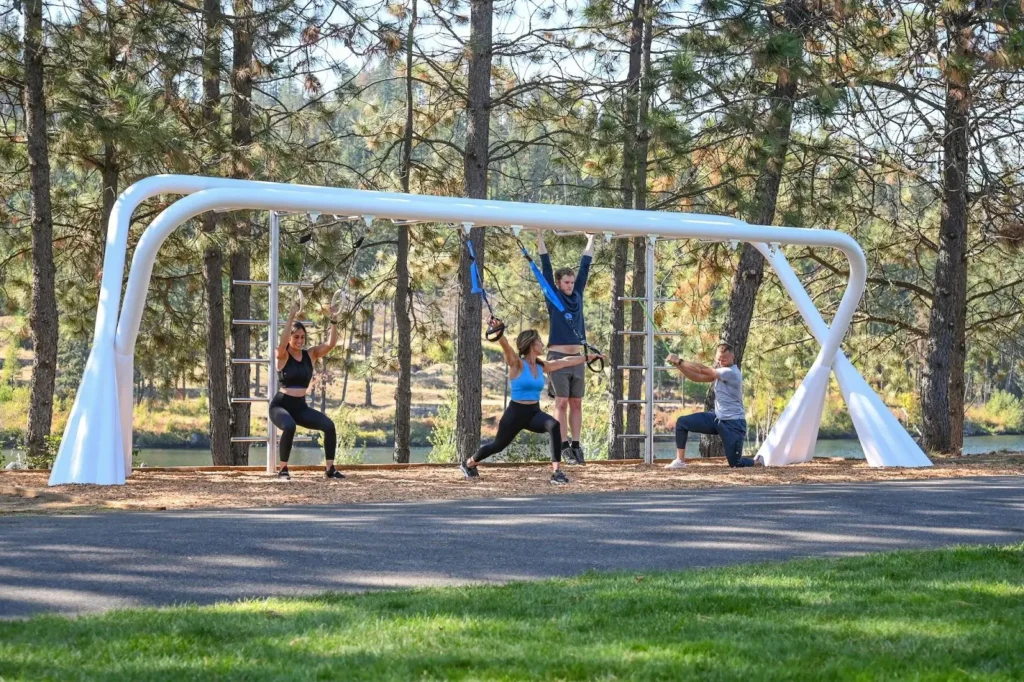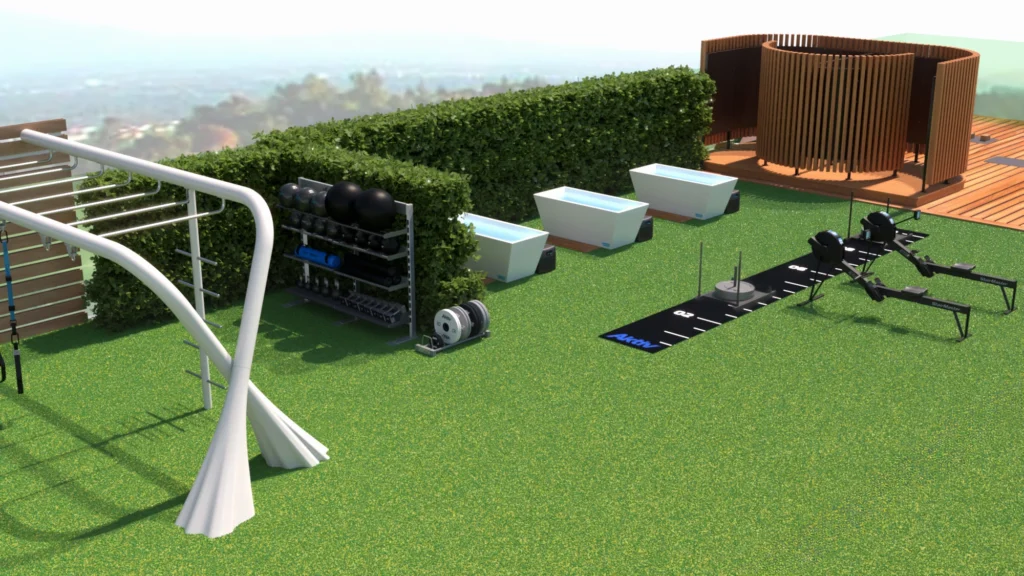Aktiv Solutions Helps Operators Build for the Next Gen of Fitness & Wellness
Partnership
Sponsored By Aktiv Solutions

Aktiv founder and CEO Bryan Green believes the physical layout of the fitness floor is as important as the quality of equipment offered
As the tastes and preferences of the modern fitness and wellness consumer evolve, so too must the physical layouts of facilities, whether they be large gyms or amenitized spaces in hotels, corporate wellness centers and apartment complexes.
Aktiv Solutions, a commercial and home gym design company specializing in movement-based training, is helping fitness operators leverage some of the dominant trends in the market today, namely the rise in strength training modalities and the increased importance of recovery.
As strength training explodes in popularity, Aktiv helps fitness facilities build spaces that cater to the many ways consumers engage with the modality, from Olympic lifting to functional training with things like kettlebells, sandbags or even body weight.
Aktiv’s founder and CEO Bryan Green believes the physical layout of the fitness floor is as important as the quality of equipment offered.
“Modern fitness floor planning requires a deep understanding of expected simultaneous exercise use and traffic flow,” Green says. “Programming for movement-based modality differs greatly from planning rows of cardio or a circuit of selectorized strength machines. With an explosion of workout types that require a large variety of movement patterns, gym design today is far more art than science and demands flexibility to accommodate consumer expectations”.
Strength Training in the Modern Era
According to Green, it’s not simply old-school weight lifting that’s become popular post-pandemic, but functional training exercises that incorporate resistance, or what he terms more broadly as “movement with load.”
“The pandemic for all its faults also forced an increase in creativity around how to work out with less large format equipment at home,” he notes. “This has stimulated a real ascendancy of functional movement and function training types, where you can utilize everything from soup cans to kettlebells.”

The increased awareness and subsequent demand for a new level of training variety have pushed commercial fitness facilities to raise the bar in terms of their own creativity, Green believes.
“This wave is still only beginning to force significant change among all operator types,” he says. “Not simply in terms of how they approach the re-balancing of equipment on the fitness floor, but how they must guide participants in the training environment through live or increasingly digital-based coaching.
Aktiv, for its part, is helping fitness facilities optimize for space by addressing smart footprints for the equipment it creates. Aktiv’s new GYM RAX® FORMA™Strength Series combines Olympic lifting with bodyweight stations like dips, a pull-up bar, a step-up station and a landmine all in what it says is the smallest functional footprint in the commercial fitness industry.
According to Green, the FORMA line was more generally conceived to cater to the growing functional-movement market.
“Forma is a bridge of sorts for those that want to engage in functional movement, but want to utilize a heavier load more safely,” he says. “Olympic training and plate weight training allow for that.”
Aktiv’s signature Apogee line more broadly accommodates the storage of many different types of equipment, like kettlebells, medicine balls and training mats, all within its highly regarded Bay and Bridge design. The company also more recently released its outdoor fitness solution, Ecosystem, a nature-inspired structure that includes suspension training, tethered resistance and accommodations for modalities as unique as aerial yoga.

Amenitized Spaces Offer New Possibilities
It appears that one thing is for sure: where people intend to work out going forward is far more varied than where they used to do so.
According to Green, exercise space accommodation has become an expectation for many where we live, work, and play.
“Aktiv is a design-first company, and as such the vast majority of our engagements indicate that the balance is changing dramatically in terms of where new gyms will be found,” the Aktiv founder says. “Both in terms of indoor and outdoor spaces, but ultimately convenience is driving a change in the proximity to how operators are meeting consumers where they are.”
Aktiv works with leading hotel groups, corporations looking to attract employees back to work and a large variety of mixed-use property developers who must increasingly accommodate residents that expect a great gym steps from their door. Green believes these amenitized spaces are the “most fascinating growing area of the commercial fitness industry,” as consumers are increasingly seeking greater nuance and a more socially driven experience during exercise.
To that end, Aktiv recently partnered with Xponential Fitness to create a specialized X+ Training Bay that includes a personalized functional training pod, custom flooring, and a complete kit of equipment to support a digital training experience, on-demand. As a result of the collaboration, fitness enthusiasts can now engage with Xponential’s ten boutique fitness brands in hotels, universities and corporate wellness centers across the nation.
“It really becomes the participant’s personalized space,” Green says. “You can do virtually any workout you want with one of the best coaches for it on the planet.”
How Can Traditional Gyms Compete?
Large gyms and health clubs are naturally adjusting to attract those seeking all the current fitness and wellness trends, but many are in need of larger adjustments, and in some cases must be willing to let go of old ways of doing business.
For example, many facilities are quickly opening up their fitness floors, ditching some of their weight machines and jettisoning a good amount of single-purpose cardio equipment in favor of more creative functional training spaces.
“There are most certainly some strong examples of large format health clubs that have modernized well and embraced the change,” Green says. “They’re really building interactive ‘adult playgrounds.’”
For those gyms, creating open functional training spaces has the potential to solve a long-running problem in terms of member engagement.
“Gyms still have a lot of folks roaming around their large floor plans with less purpose or comfort towards engaging with the more abstract areas of functional training space,” Green says. “They’re just not clear on what to do with all the equipment and in the absence of effective guidance, many end up spending 30 minutes on the treadmill and call it a day.”
Offering a more interactive and immersive environment seemingly will go a long way toward combating member boredom and confusion, which should in turn reduce churn.

The Rise of Recovery
Another trending area of fitness and wellness is the rise of innovative new recovery modalities, including cold water immersion and percussion therapy. On the recovery side, Aktiv is helping fitness facilities tap into consumers’ increasing demand for pre and post-workout options that go beyond plain, old foam rolling.
Aktiv also recently partnered with Plunge, a leading maker of cold plunge baths, to bring this emerging recovery modality to fitness operators of all types. Aktiv is now working with clients to design elegant spaces that feature Plunge tubs.
As cold water therapy grows in popularity, Green believes this is an area where gyms can leverage their space to give members access to a premium experience.
“Gyms have large areas that traditionally include locker rooms or wet rooms, and many over time have had pools or saunas,” he notes. “Cold water immersion is now an essential element to consider if you’re fortunate enough to have the space type required to accommodate it.”

Aktiv also has a long-running partnership with Hyperice, designing Recovery Bays that store the wellness tech company’s tools and products.
No matter the modality, merging fitness with recovery can help facilities stand out by offering their members a more holistic wellness experience.
“There’s a gap between what the world thinks of as a spa and what it thinks of as fitness,” Green believes. “The bridge between that gap is active recovery.”
Looking ahead, Aktiv is confident that no matter where the fitness and wellness space heads, its less-is-more approach to gym design will leave its clients in the best long-term position for success.
“We know there’s going to be something new next year and the year after,” Green says. “Our job is to anticipate that so that our customers, the operators, can adapt their businesses without changing their entire infrastructure.”



